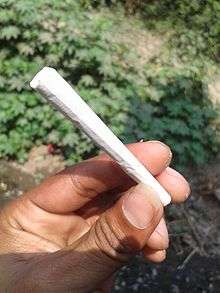Cannabis in Bangladesh
The cultivation, transport, sale, purchase, and possession of all forms of cannabis has been illegal in Bangladesh since the late 1980s, but enforcement efforts are lax and the drug continues to be popular there. But since 2017 enforcement has become harsh on marijuana laws and have been cracking down on cannabis. Causing spike in price of marijuana at an alarming rate still it continues to be popular. It is unclear what the government wishes to achieve when other harsher drug trades are booming

Prohibition
Conspiring with US President, Ronald Reagan,[1] Bangladesh Government, under dictator Ershad, banned the cultivation of cannabis in 1987, and banned its sale in 1989.[2] The current law governing cannabis in Bangladesh is the Narcotics Control Act 1990;[3][4] the Act gives the courts discretionary ability to impose the death sentence for possession of cannabis over two kilograms.[5]
Culture
Cannabis and opium have been traditionally used by Bangladeshi people. Today in Dhaka cannabis can be found through local dealers in underground operations evading law enforcement but if caught the police can be bribed. Every year a festival is held in Kushtia, Bangladesh, in memorial of the late folk singer Fakir Lalon Shah. Many folk gather every year at the festival there are westerners and people from West Bengal, India as well. It can be seen that during the festival period people are singing Bengali folk music and smoking marijuana out of a chillum freely. All these means is to be connected with each other spiritually and remembering the great Lalon Shah through music. During the festival period marijuana consumption is tolerated and enforcement provides protection for the festival so that everything is accordingly.[6]
Cultivation
The 2005 UNODC Bangladesh country profile notes:
Cannabis is still cultivated, particularly in the districts of Naogaon, Rajshahi, Jamalpur and Netrokona in the northwestern region, as well as the hilly districts near Cox’s Bazaar, Bandarban, Khagrachhari and Rangamati in the southeast (bordering Myanmar). Reliable figures for the total area of cannabis production in Bangladesh are not available, but cultivation in the Chittagong Hill Tract region is reportedly on the increase.[7]
See also
References
- "Making National Drug Policies a Development Priority A Strategy Paper and Six Country Stories" (PDF).
- "Drug Abuse: Where is The Way of Remedy? (Part II- Some Dangerous Silent Killers)". DhakaInsider. 2014-06-20. Archived from the original on 2016-11-15. Retrieved 2016-11-15.
- Barrister Omar Khan Joy (2010-03-27). "Your Advocate". Law and Our Rights. The Daily Star. Retrieved 2016-11-15.
- "Narcotics Control Act,1990 (Bangladesh)" (PDF). UNODC.
- Roger Hood; Carolyn Hoyle (2008). The Death Penalty: A Worldwide Perspective. Oxford University Press. pp. 138–. ISBN 978-0-19-922846-1.
- "Dhaka, Bangladesh". Archived from the original on 2017-09-25. Retrieved 2017-10-03.
- "Asia Regional Profile: Bangladesh" (PDF). UNODC: 10. September 2005.